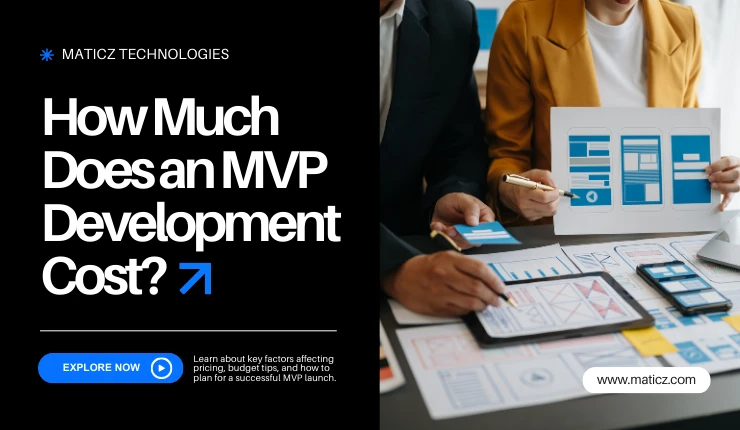Share Posts

How Much Does It Cost to Build an MVP? Guide for 2025
47
1365
103
How much would it cost in reality to make an MVP? It's questions like these that often bother the minds of numerous startups as development in an MVP is purely the balance of cost, speed, and quality. Knowledge about such aspects makes a great deal of sense even in 2025 when it comes to deciding properly and spending money accordingly.
So, what goes into MVP development costs? How should one plan for their budget wisely? Should it be with an in-house team, third-party vendors, or no-code tools? Well, that all depends on your goals and your resources.
We shall discuss the cost of developing MVP, go through various pricing models, and share practical tips on building a cost-effective MVP without losing quality. Let's get started.
Understanding Minimum Viable Product (MVP)
The MVP is typically a similar version of the product with a minimal set of features to ensure that the product meets the early users' requirements and gives feedback on future improvements. The basic principle is to rapidly validate a business concept with as little effort and investment as possible.
MVPs target solving a specific problem for a targeted audience. They are not supposed to be feature-rich but instead, the core elements to validate the demand in the market. This helps identify if an idea is viable enough to pursue without spending large sums of money on its full development.
Why is MVP Development Important for Startups?
MVPs help reduce the chances of unacceptable parameters and, consequently, ensure the value of the product is on par with what users need. One of the best ways of reducing risks is by developing an MVP. The MVP helps test ideas, receive user feedback, and improve products before a full launch. This is why MVP development is a must for any startup.
Faster Time-to-Market
In today's quick-paced world, businesses need to release products on time to avoid being outstripped. It enables them to focus on their core features, which helps the product reach markets sooner.
User-Centered Design
Launching the MVP early means that companies gather real-world feedback from users, hence helping in developing the product to fulfill the needs and requirements of customers.
Cost Efficiency
By targeting core functionalities, MVPs avoid businesses spending too much on features that may not easily strike a chord with users. This lean approach maximizes resources spent wisely.
Risk Mitigation
Starting a new business is quite a risk. One cannot make a full-featured product without testing, as that would surely fail. An MVP can help minimize risks for a startup by testing its ideas on real users. In case the idea does not catch up, one can pivot or change direction without wasting too much of anything.
Iterative Improvement
MVP development is an iterative process. Startups release a minimum version, gather feedback, and refine it over time. Thus, instead of some assumptions, the product will evolve based on actual usage.
How Much Does It Cost to Build an MVP?
MVP pricing is influenced by parameters such as the complexity of the product, the number of feature sets, and the location of the development team. For a relatively simple MVP with basic features, the development cost can be from $15,000 to $100,000, whereas a complicated one can cross $150,000 or even more.
The task is usually executed in a small team of two to five members, comprising a designer, a developer, and a project manager. However, the final verdict on cost depends upon what features you want, what tech stack you go with, and how much customization you need.
Pre-Development Cost of MVP
Before development, there are various costs for pre-development: research, planning, and design costs. For any startup, one must perform a market survey and identify its target market so the MVP will meet the user's requirements, and there is less unnecessary spending during development time. Pre-development costs usually fall between $2,000 to $10,000.
Development Cost of MVP
The coding, integration of essential features, and testing make up a huge share of expenses when building an MVP. The costs of development further depend on how many features, the technology selected, and the expertise of the team who will discuss it later. Generally, development is in the range of $10,000-$100,000.
Post-Development Cost of MVP
After launching the MVP, hosting, maintenance, marketing, and customer support are the added costs. These post-development costs can be a little more varied but normally run between $5,000 to $20,000 in the first few months.
Factors Affecting the MVP Development Cost
It is mandatory to understand the factors that affect the costs of MVP development. Here, let’s see about each of the factors to find out how they affect the overall cost.
UI/UX Requirements
Development cost is highly dependent on the complexity of the design. A simple UI/UX with minimal design elements is inexpensive because it would require less development time, fewer graphic assets, and basic coding efforts.
Conversely, a highly customized and interactive design increases costs in terms of the additional development time and resources that are required. Advanced UI/UX may incorporate custom animations, interactive elements, micro-interactions, and high-end graphics. All these call for specialized skills in design as well as intense coding efforts.
| UI/UX Design | Estimated Cost Range |
| Basic | $2000 - $5000 |
| Intermediate | $5000 - $10,000 |
| Advanced | $10,000 - $20,000+ |
Scope and Features Complexity
The scope and complexity of features can deeply establish the development cost for an MVP. A basic MVP has limited core functionalities, including user login, essential product operations, and a simple user interface. At the same time, advanced features like AI and AR, blockchain, or complex third-party integrations significantly raise the development cost due to extended development time and high technical requirements.
| Feature Scope | Description | Estimated Cost |
| Basic MVP | Includes fundamental features like user login, basic product functionality, and a simple UI. | $10,000 – $30,000 |
| Advanced MVP | Features AI, AR, blockchain, or complex integrations. | $50,000 – $150,000+ |
Technology Stack Used
The other important factor determining the costs of an MVP is the technology stack. While some stacks are inexpensive and quick to develop, others involve the use of advanced technologies that require expertise and, hence, more significant budgets. All these aspects are included in the frontend and backend technologies, database solutions, and hosting infrastructure.
| Technology Stack | Description | Estimated Cost |
| Basic Stack | MERN (MongoDB, Express, React, Node) or LAMP for cost-effective development. | $15,000 – $50,000 |
| Advanced Stack | Serverless architecture, AI/ML integrations, or cloud-native solutions. | $50,000 – $100,000+ |
Team Size and Expertise
Structural aspects and expertise teams form the backbone for determining MVP cost. Businesses could opt for either freelancers or development agencies and in-house teams, each offering its own pros and cons along with cost implications. Specialized skills, as in AI and blockchain, hike the costs too.
| Team Type | Description | Estimated Cost |
| Freelancers | Cost-effective but may face coordination challenges. Hourly rates: $50 – $150. | $10,000 – $50,000 |
| Development Agency | Offers a professional approach with premium pricing. Hourly rates: $75 – $200. | $50,000 – $150,000+ |
| In-House Team | Includes salaries, benefits, and overhead costs. Best for long-term projects. | $100,000 – $300,000+ |
Geographical Location
The geographical locations of the development team have had a significant bearing on labor. Offshore has become very prominent, and more teams in Eastern Europe and Asia are offering high value at lower prices. However, businesses should also watch out for aspects like communication time zones and even cultural differences.
| Location | Hourly Rate Range | Description |
| North America & Western Europe | $100 – $250 | High-quality, high-cost regions. |
| Eastern Europe | $30 – $80 | Affordable with skilled developers. |
| Asia (India, Philippines) | $15 – $50 | Most cost-effective option. |
Development Methodology and Tools
The development methodology used can affect both cost and quality. Agile methodologies, which focus on iterative development and user feedback, are the most commonly used for MVPs in 2025. While Agile can slightly increase costs, it often results in a better final product. Modern tools for project management and collaboration can also help reduce overhead expenses.
| Methodology/Tools | Description | Cost Impact |
| Agile | Allows iterative development for improved product alignment. | Adds 10% – 20% to base cost |
| Tools (Jira, Trello, Slack) | Streamline project management and collaboration. | Minimal but valuable investment |
Tips to Reduce the MVP Development Cost
The process involved in MVP creation demonstrates the necessity of getting the ideas of potential customers to synchronize with testing and development. However, unless planned properly, costs can soon mount up. Here are some tips to help reduce MVP development costs without sacrificing quality.
1. Outsourcing MVP Development
MVP outsourcing to experienced agencies or freelancers can save costs by a large amount. You access developing talents without having to worry about salaries, benefits, or infrastructure costs. A second important point is that it gives you the flexibility of uptaking the workforce up or downsizing.
2. Prioritize Features for Your MVP
One major mistake that many startups make is trying to build the full product right at the beginning. Whereas it makes much more sense to only create the core feature that solves the primary problem that your users want solved.
3. Consider Open-Source Solutions
Instead of building MVP from scratch, use open-source technologies. There are plenty of free and reliable tools, frameworks, and libraries that can save costs. Platforms like WordPress, React, and Laravel provide ready-to-use solutions.
4. Embrace Lean Development
Lean development is based on building, testing, and improving in short cycles. Collecting feedback in small cycles helps to avoid the wastage of time and resources in unnecessary work by making fast changes.
5. Go for Offshore Development
Hiring developers from countries which present lower labor costs saves much money. These offshore development teams can provide high-quality work at very low prices compared to hiring local developers.
6. Consider a Fixed Price Model
If you plan to outsource, a fixed-price contract makes it easier for you to understand the costs going into the outsourced work; instead of giving the service a flat rate according to hours with potential expenses climbing up unexpectedly in hourly payments.
Develop Your MVP With Maticz
Planning well and choosing smartly doesn't have to be expensive while developing an MVP. You will cut costs quite drastically by only choosing the important features, making use of open-source solutions, and outsourcing work to expert developers. The key is to work with an experienced MVP development company that understands your vision and delivers a cost-effective solution.
Maticz is the best-in-class MVP development company specializing in creating scalable, high-performing MVPs for the speedy validation of your startup ideas. Our skilled developers work in a lean development manner, and that way, you get the functionality of your product without overspending. Whether you require a web application, mobile application, or blockchain-based MVP, we got you covered. Contact Maticz today to get your MVP development started.
Tap Into the Future
The latest insights, posts, and project updates - straight to your inbox.




